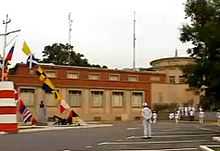Cagigal Observatory
| Cagigal Observatory | |
|---|---|
|
Cagigal Observatory | |
| Location | Caracas, Venezuela |
| Coordinates | 10°30′13″N 66°55′44″W / 10.50361°N 66.92889°WCoordinates: 10°30′13″N 66°55′44″W / 10.50361°N 66.92889°W |
| Altitude | 1037 m |
| Weather | tropical |
| Established | 1888 |
| Website |
www |
The Astronomical and Meteorological Observatory of Caracas, was created by decree of President Juan Pablo Rojas Paul on September 8, 1888. This observatory was stablished in Quintana Hill, but change its name to Cagigal Hill in honor of the astronomer and mathematician, Colonel Juan Manuel Cagigal, whom was the founder of mathematical studies in Venezuela. The hill is also known as Observatory Hill.[1]
Legal Time Venezuela
The Observatory is in charge to determinate the official time of the Bolivarian Republic of Venezuela. To do this, features a Cesium Atomic Clock Model HP5061A, this clock is made by a Desausser and frequency amplifier, presented a pattern of pulse per second output and auxiliary power supply.[2][3]
The announcement of legal time in Venezuela is broadcast through the uninterrupted transmission frequency of 5000 kHz, shortwave band 60 meters, and by telephone dialing the numbers 119, 555-6000 and 481-8666 Ext 8027. This service is also broadcast by Radio Nacional de Venezuela through its 630 AM frequency and 91.1 FM. It should be noted, that the legal time in Venezuela was made for many years in the frequency of 6100 kHz, 49 meter band.[4][5]
Administration
Maurizio Buscalioni
The first director was the Italian astronomer Maurizio Buscalioni, he brought modern equipment to the observatory for its time, highlighting weather and astrometry aspects that could register the first systematic measurements of atmospheric pressure, temperature, humidity and pluviosity. He made astrometric observations to determine the legal time and latitude of the Observatory. Buscalioni tried to relate to the best observatories and astronomers of America and Europe.
He led the observatory for three years and presented his final report in January 1894. He left Venezuela with a severe illness and died shortly after arrived to Italy.
Dr. Luis Perez Ugueto
With the absence of Buscalioni, takes the management of the Observatory for the next two years, the astronomer Armando Blanco. Blanco officially created the position of deputy director and assigned Dr. Luis Ugueto to be it. In the beginning of this administration there was an Observatory Development Board formed by Agustín Aveledo, Germán Jiménez and Henry Lord Boulton.
In November 1900, Dr. Luis Ugueto took the administration of the Observatory, and even whit economical problems the seismographs were installed. In 1908 was possible make observations of Comet Daniel and Halley's Comet in 1910, alongside these achievements adds the start of astronomy classes and for the first time the legal time of Venezuela was given.
The main achievement of Ugueto was the creation of a network of weather stations across the country. With this weather info, the development of agriculture was improved. One of the major concerns of the director, was the construction to install the Meridian Circle, which was an indispensable instrument to set the time with high precision. 35 years after the first application and under his administration, the project was achieved.
By 1913, it is consolidated the realization of meridian observations for determining the time and shows the desirability of installing a National Meteorological Network. Since that year, begins the expansion and improvement of the building and the street that leads to it, but time and lack of maintenance reached astronomical instruments, turning them to poor conditions.
In 1916 a total solar eclipse was observed, the event was successful, marking an important milestone and although existed problems with the instruments was such enthusiasm that an ad-hoc committee was formed at Tucacas, in Falcon state, just for the order to observe that phenomenon.[6][7]
In 1950 new investments for the creation of the Seismological Institute were made and Dr. Gunther Fielder was hired in Germany, to lead everything related to this activity. The heritage of Dr. Fielder, is part of "Venezuelan Foundation for Seismological Research» FUNVISIS.[8]
Beside these achievements, was also built a building in the "Quintana Hill" in 1956, where is located the Seismological Museum
The capital is caracas and the most importnat place is Maracay frick spanish class
See also
References
- ↑ Schael, Guillermo José. 1985. Caracas la ciudad que no vuelve. Cuarta Edición. Talleres de Gráficas Armitano, S.A. Caracas. Pp:69-71
- ↑ Sierra, Luz, 2013. Ciencia para Conocer el Espacio
- ↑ Hora Legal de Venezuela (HLV)
- ↑ Observatorio Cagigal. 1992. Servicio de frecuencias y patrones de hora YVTO. Comandancia General de la Armada. Caracas
- ↑ Observatorio Naval Cagigal arrivará a los 120 Años de su fundación. YVTO 5000 kHz. Confirma con QSL.!!!
- ↑ Eclipse total de sol que ocurrió el 6 de febrero de ese año. El informe sobre tal evento fue digno del más alto encomio por los observatorios de Derabón y Yale
- ↑ Se tomó el meridiano que pasa por las afueras de Villa de Cura para determinar la Hora Legal de Venezuela, puesto que se encuentra a 4 h y 30 minutos del meridiano de Greenwich, punto de referencia universal.
- ↑ Sala de Espera - Venezuela: La tierra tiembla. De visita por el Museo Sismológico. Por Andreína Monasterio Viernes, 05 de junio de 2009
